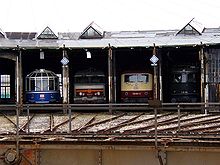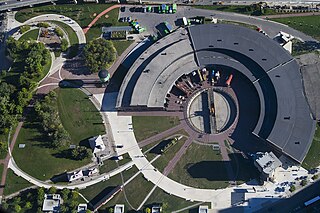
A railway roundhouse is a building with a circular or semicircular shape used by railways for servicing and storing locomotives. Traditionally, though not always the case today, these buildings surrounded or were adjacent to a turntable.

A motive power depot (MPD) or locomotive depot, or traction maintenance depot (TMD), is where locomotives are usually housed, repaired and maintained when not being used. They were originally known as "running sheds", "engine sheds" or, for short, just sheds. Facilities are provided for refuelling and replenishing water, lubricating oil and grease and, for steam engines, disposal of the ash. There are often workshops for day to day repairs and maintenance, although locomotive building and major overhauls are usually carried out in locomotive works.
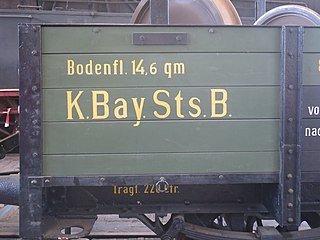
The Royal Bavarian State Railways was the state railway company for the Kingdom of Bavaria. It was founded in 1844. The organisation grew into the second largest of the German state railways with a railway network of 8,526 kilometres by the end of the First World War.

The Franconian Museum Railway is an association whose purpose is to preserve and promote interest in historic railway vehicles. Since 1996 it has been accredited also as a railway company.
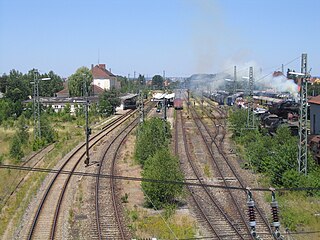
The Bavarian Railway Museum is a railway museum based in the old locomotive sheds at Nördlingen station in Bavaria, Germany. It is home to more than 100 original railway vehicles and has been located in the depot at Nördlingen since 1985.

The Nuremberg Transport Museum is based in Nuremberg, Germany, and consists of the Deutsche Bahn's own DB Museum and the Museum of Communications. It also has two satellite museums at Koblenz-Lützel and Halle. The Nuremberg Transport Museum is one of the oldest technical history museums in Europe.

The Darmstadt-Kranichstein Railway Museum is a railway museum in the German city of Darmstadt. It is also the largest railway museum in the state of Hesse.

The German Steam Locomotive Museum or DDM is located at the foot of the famous Schiefe Ebene ramp on the Ludwig South-North Railway in Neuenmarkt, Upper Franconia. This region is in northern Bavaria, Germany. The DDM was founded in 1977.
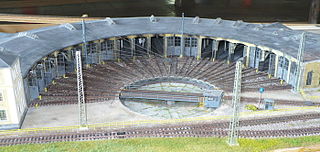
The Freilassing Locomotive World is a railway museum in the Berchtesgadener Land, which is operated with the cooperation of the town of Freilassing and the Deutsches Museum. The museum is located on the site of the former Freilassing locomotive shed which belongs to the Deutsche Bahn AG and houses part of the Deutsches Museum's railway collection. The second part of the collection is in the transport centre of the Deutsches Museum on the Theresienhöhe in Munich.

The German Class 41 steam locomotives were standard goods train engines (Einheitslokomotiven) operated by the Deutsche Reichsbahn (DRB) and built from 1937 to 1941.

The South German Railway Museum is a railway museum at Heilbronn in the state of Baden-Württemberg in southwestern Germany. It was founded in 1998.

The Ulm Railway Society is a German society for encouraging the preservation of historically valuable railway stock. It is based in the vicinity of Ulm, a city in the state of Baden-Württemberg in southern Germany. The society was founded in 1969, has about 600 members and around 12 steam locomotives as well as numerous historical wagons.

The Saxon Railway Museum is located in Chemnitz, in the state of Saxony, eastern Germany. It is situated on the site of the former locomotive depot for goods train locomotives in the district Hilbersdorf.

The Munich Steam Locomotive Company is charitable society based in Munich, Germany, whose aim is to preserve the oil-fired steam locomotive, number 41 018, as an operational locomotive.

Junee railway station is a heritage-listed railway station located on the Main South line in New South Wales, Australia. It serves the town of Junee in the Junee Shire. It was added to the New South Wales State Heritage Register on 2 April 1999.
There were a number of engine sheds and railway works located in York. The large York North engine shed became the National Railway Museum in 1975.
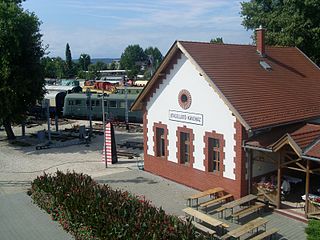
The Magyar Vasúttörténeti Park is a railway museum located in Budapest, Hungary at a railway station and workshop of the Hungarian State Railways (MÁV), the former Budapest North Depot. The museum covers more than 70,000 square meters and it features over one hundred exhibits, mostly including railway vehicles and equipment.

Broadmeadow Locomotive Depot was a large locomotive depot consisting of two roundhouse buildings and associated facilities constructed by the New South Wales Government Railways adjacent to the marshalling yard on the Main Northern line at Broadmeadow. Construction of the locomotive depot at Broadmeadow commenced in 1923 to replace the existing crowded loco sheds at Woodville Junction at Hamilton, with the depot opening in March 1924. It was added to the New South Wales State Heritage Register on 2 April 1999.

The Junee Roundhouse Railway Museum preserves the former Junee Locomotive Depot, a railway depot located on the Main Southern line in Junee, Australia.
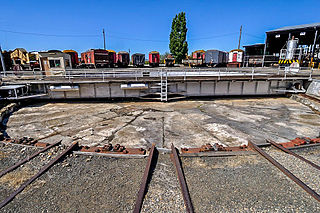
The Goulburn Rail Heritage Centre is located at the heritage-listed former railway workshops in Goulburn, New South Wales, Australia, on the Main Southern railway line. Now a museum, it is also known as the Goulburn Rail Workshop and Goulburn Roundhouse. The workshops were added to the New South Wales State Heritage Register on 2 April 1999. The workshops were saved from demolition by the Goulburn Locomotive Roundhouse Preservation Society and is now a museum open to the public with large collection of rolling stock and various exhibits, as well as privately owned locomotives and carriages with some commercial repair work happening on site.
